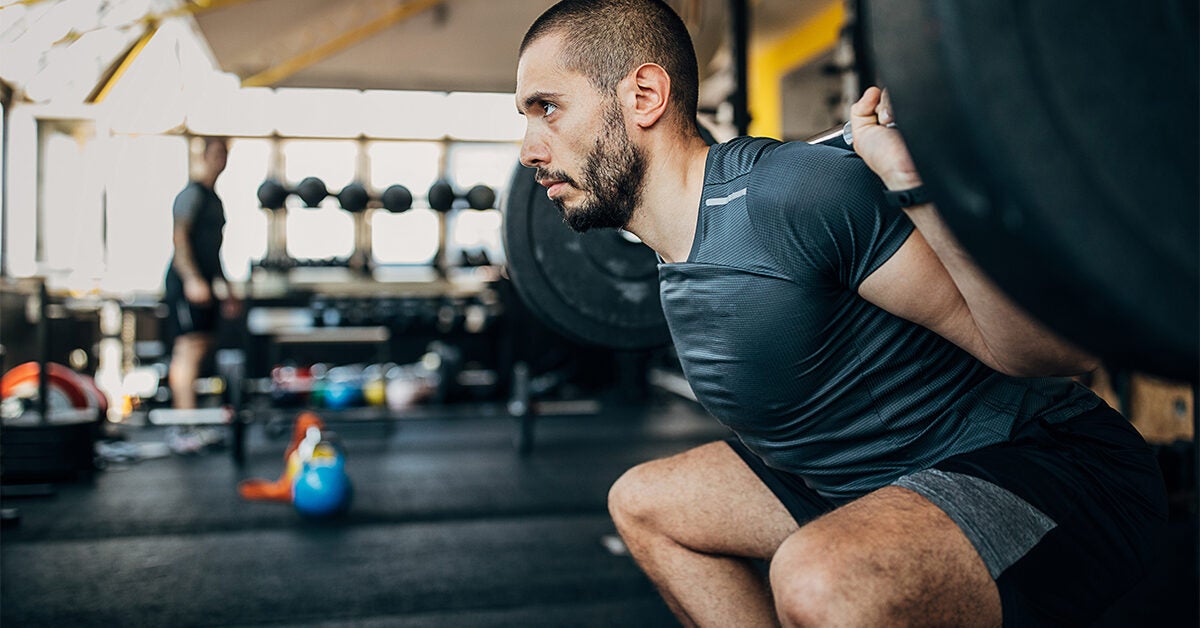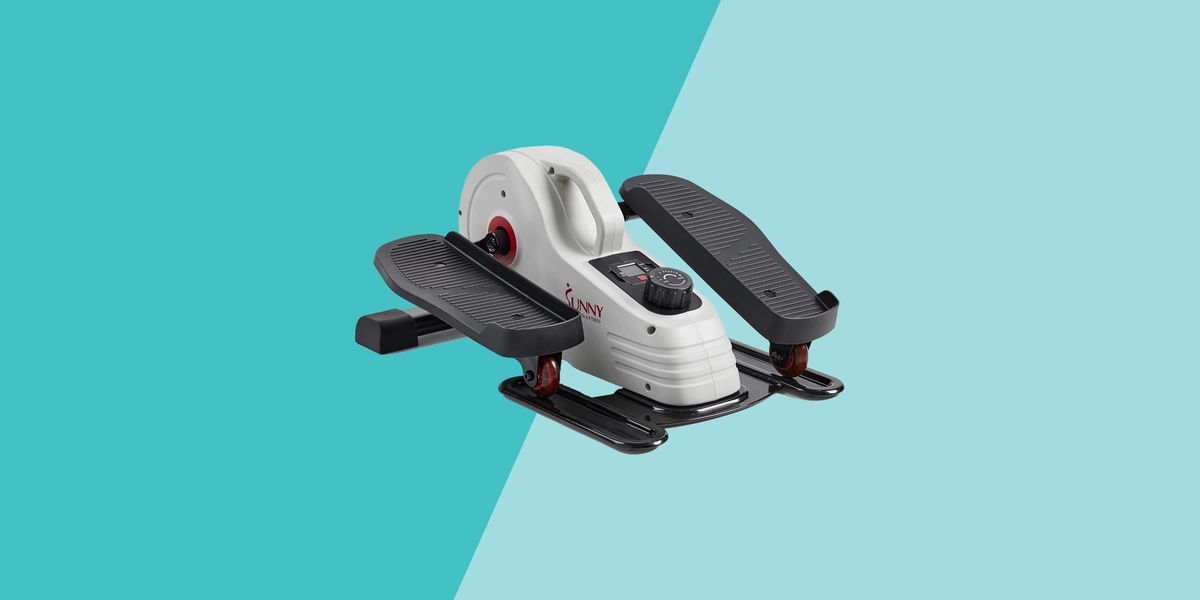Table of Contents
Want to bulk up fast without having to think too much about it? Welcome to the 5×5 program!
The 5×5 workout (aka “Strong Lifts 5×5”) lives in the overlap between simple and effective. By repeating low rep sets of compound barbell movements, you’ll push your body to its limits and have sweet, sweet gains to show for it.
Whether you’re an experienced lifter looking for a new program or a total barbell rookie who wants to know if the hype is real, here’s everything you need to know about the 5×5 workout.
Every movement in a 5×5 program is a compound barbell movement. Throughout the program, you’ll be doing workouts that are combinations of the following 5 movements:
- barbell back squat
- barbell bench press
- barbell deadlift
- barbell overhead press
- barbell row
The focus is on low reps with heavy weights. After completing each 2-week cycle, you’ll add more weight.
You’ll do 5 sets of 5 reps for each movement (hence the name “5×5” — clever, eh?). The only exception is deadlifts. You’ll do just one 5-rep set of those. Why? For injury prevention reasons, which we’ll expand on a little later.
Rest days are key to the 5×5 program. You’ll be hitting those weights only 3 times a week. The program is arranged on alternating Week 1/Week 2 schedules, and within each week, there’s Workout A and Workout B.
It might look a little like this:
Week 1
Workout A (Monday and Friday):
- barbell back squat, 5 sets of 5 reps (5×5)
- barbell bench press, 5×5
- barbell row, 5×5
Workout B (Wednesday):
- barbell back squat, 5×5
- barbell overhead press, 5×5
- barbell deadlift, 1×5
Week 2
Workout A (Monday and Friday):
- barbell back squat, 5×5
- barbell overhead press, 5×5
- barbell deadlift, 1×5
Workout B (Wednesday):
- barbell back squat, 5×5
- barbell bench press, 5×5
- barbell row, 5×5
Squats are always completed first in a 5×5 workout. Barbell back squats require an incredible amount of core stabilization. Attempting them when fatigued doesn’t just mean you’ll get a subpar workout — it’s also a serious injury risk. Even overhead lifts don’t put as much strain on your core.
This is also why you’ll only ever do 1 set of deadlifts, and they’ll always be last in your workout order. Deadlifts put your core through its paces. They pose an overtraining risk by themselves, but attempting movements like back squats or overhead presses after an intense deadlift is asking for trouble.
Here’s a lighting round of some high-level pluses and minuses you might see while working this workout program.
General pros:
- It doesn’t require the involvement of a fitness pro or dietary specialist like many other exercise programs. And you don’t need tons of fitness knowledge or expensive gym equipment. If you’ve got a barbell and weights and you know the 5×5 schedule (and the proper form for each move), you’re good to go.
- The progression curve isn’t steep and still delivers results.
- The 5×5 program is perfect for beginner and intermediate lifters. It builds a solid foundation of not only strength and muscle but also movement knowledge — all of which is super important as your resistance training journey progresses.
General cons:
- It’s easy to plateau later on in the program. Having to de-load lifts once you’re a few weeks in isn’t uncommon, and the frequency only increases as you get stronger.
- The simplicity is a double-edged sword for experienced lifters, who may get bored with the repetition. This can cause motivation levels to dip.
- As with any high weight strength training, there’s always injury risk (especially if you push yourself too hard). And it’s a difficult program to jump into if you have an existing muscular injury (even an incredibly acute one). The 5×5 is a full-body workout, and it’s difficult to follow if you cannot engage certain muscles risk-free.
- There’s no accessory work to focus on smaller muscle groups.
- These workouts can take a long time. With 15 sets per workout and 4–5 minutes rest, a 5×5 workout requires 1 hour and 15 minutes — and that’s before factoring in any warmup or cooldown (you’ll need rest times like that as you progress too).
Here are 9 key reasons 5×5 can be a workout program worth loading up that barbell for.
1. Low reps mean more resistance
Because it sticks to a low rep count, 5×5 makes it easier than other workout programs if your goal is to hit the heaviest weights possible.
Higher weights create more resistance, meaning more muscle damage. Don’t worry, though — it’s the good kind of muscle damage, the kind that makes your muscles stronger once they recover from it (this is what happens every time you work out).
There’s science to back this nugget of wisdom too. A small 2015 study with 18 participants found that lifters who followed a low rep program could reach much higher levels of resistance (aka heavier weights) than those doing a higher rep program.
2. It’s a heavy workout that’s not cardio-intensive
Cardio is important, but not everybody wants to pound the treadmill until they puke. The 5×5 program is one of the best anaerobic programs available.
The movement combinations will allow you to tap into pretty much your whole body. This gives you the kind of top-to-toe workout that’s otherwise mostly found in cardio-intensive, high impact aerobic activities.
If your goal is to find a program that gives you a full-body workout, but you don’t want to destroy yourself on an indoor cycling bike or rower, then 5×5 is the program for you.
3. It grows foundational muscles to set you up for more intense lifting
The 5×5 workout works every muscle that’s important if you want to pursue weightlifting at any level above casual. Research over the last decade has found that regimented resistance training like 5×5 builds muscle bulk better than pretty much anything else.
One of the many reasons 5×5 is recommended for lifting beginners is that it doesn’t focus on one area of your body.
If you’re new to resistance training, your body will be a mishmash of strong and weak muscles. The 5×5 workout brings everything you’ll pump up to a baseline, making sure those muscles neglected during day-to-day living don’t become a weakness.
4. It’s a full-body workout 3x a week
Not much science or fitness know-how is required to understand this benefit. With the 5×5, you’ll never be stressing over whether to skip leg day. No leg days, no arm days, no back days. With 5×5, you’ve only got lift days and rest days.
5. Squats enhance knee stability
Every 5×5 workout starts with squats. A common gym myth is that squats can wear down your knees, making them unstable. This is a load of hokum, as noted by a 2001 study.
Even though that data is from a while ago, our knees haven’t done much evolving in the last couple of decades. More recent research also notes that squats can increase knee stability (when done properly, obvi).
On a similar note, the “deadlifts = guaranteed back pain” myth is also just that. Deadlifts can cause back pain, but only if you don’t do them properly or you overtrain.
Research has shown that when done sensibly, deadlifts can significantly relieve back pain. The way they’re included in 5×5 (only 1 set, right at the end of your workout, only once or twice per week) is pretty damn sensible, ain’t it?
6. It’s good for weight management
Not everyone is in a position to invest time into a super-intensive diet or a 7-day-a-week jogging habit. This is why programs like the 5×5 have been a godsend for many.
Research suggests that increasing muscle mass is great for improving metabolism. If eating less is not conducive to your needs, then this is ideal, because it means that what you eat is being processed more efficiently (broken down to build muscle tissue instead of hanging around on your waistline).
Also, as you build muscle, you’ll be burning fat. Will you see the pounds fall off? No, but numbers on the scale don’t really tell the full story. The 5×5 will help you add muscle, which is a beneficial thing to gain.
7. 5×5 works for ANY skill level
As established, 5×5 is ideal for entry-level lifters. The world of fitness and strength training can feel hella intimidating for a rookie. There’s a dizzying number of programs and schools of thought, and the choice can feel overwhelming.
The 5×5 uses a low rep count, simple movements, and an easy-to-follow schedule, and it’s designed to be approachable even if your lift limit is an empty barbell.
8. You’ll yield massive, massive gains
Just in case we haven’t stressed this enough, the main reason 5×5 is so popular is that it drives massive gains. The debate is never “Does 5×5 increase muscle mass?” — it’s “Is 5×5 better for gains than [some other workout program]?” Experienced lifters never doubt that 5×5 is a gain-maker. They just quibble over the finer details.
Beginner/intermediate gains-chasers will see results with the 5×5. This isn’t just anecdotal knowledge, either — research backs it up. Muscle hypertrophy (growth) has been shown to increase in correlation with resistance (the amount of weight you lift). With its “low reps, big weights” attitude, 5×5 is ideal if muscle size is your goal.
9. It puts your prime movers and stabilizers through their paces
A 5×5 workout involves your whole body. However, a few muscles will go the extra mile (and thus feel extra-worked). Mainly, these are your prime movers and stabilizers.
Why are these important? Because they’re the large muscle groups essential for generating force to move weight and keeping you firm while you’re doing it.
These include your:
- quads, glutes, and hamstrings (hit with the squat and deadlift)
- deltoids (shoulders) and triceps (hit with the overhead press)
- pecs (chest), deltoids, and triceps (hit with the bench press)
- rhomboids (back), lats (back), and biceps (hit with the barbell row)
- stabilizers across your torso, including your lumbar multifidus, internal and external obliques, and upper/middle/lower trapezius (hit in every 5×5 movement)
During intense resistance training like 5×5, there’s no shame in tapping out of a set — especially once you’re a few weeks into the program and lifting heavier loads. Here are some common reasons folks might not finish a set (and how to best rectify them).
Improper form
Completing 5 reps of any of the 5×5 movements should be only as difficult as the load you’re lifting. With proper form, the kinetics of the movements alone shouldn’t put your muscles under rep-stopping strain.
Improper form is a different story. Find a mirror or a spotter if you can. Ask a spotter to assess your form, or monitor it yourself in your reflection. A bent lower back or turned-out heel could be what’s holding you back.
Too much weight
The incremental weight increase of 5×5 isn’t a shock to the system, but that doesn’t mean you’ll always be able to handle the extra load. Everyone has different limits, and there will be weeks when an extra 5 pounds feels way heavier than others.
If you’ve upped the weight and find yourself tapping out of a set, reduce it and finish. Wait until you can comfortably complete a set with your target weight before increasing again.
Incorrect pacing
Some folks like to charge from movement to movement without giving themselves adequate rest time. But giving your body a chance to rest between sets is essential. It could be that you need an extra minute or two between sets, especially with loads proportionally much higher than your body weight.
Veterans of 5×5 spend most of their workout time between sets, and there’s a reason. It’s not laziness — it’s proper resting etiquette.
Working out while injured
The alarm-bell reason for set failure is injury. Feeling the burn is one thing, but if you experience pain during a set, STOP what you’re doing. Put down the barbell and consult a specialist, such as a physical therapist.
Weightlifting injuries can be serious, and pushing yourself to complete a set to save face isn’t worth the risk.
One key drawback of the 5×5? It’s easy to plateau, especially when you’re pretty far into the program.
If you’re plateauing and finding it difficult to hit your target weights, don’t worry. There are a few things you can do to get back on track:
- Take a de-load week for muscle recovery. While undertraining is rarely a 5×5 risk, the same can’t be said for overtraining. Try loading only 50% of your target for a week, and then pick back up where you left off afterward. This allows your body to recover from overtraining without losing the progress you’ve already made.
- Track your progress. This is a tried-and-true mental motivation hack. Nothing gets you pumped like checking the numbers and seeing how much progress you’ve made since starting the 5×5 program.
- Check your fuel and rest levels. Progress tracking can also come in handy here. If you’re plateauing after spending a couple of long weekends out on the town or staying up into the wee hours watching that latest Netflix series, it’s likely the plateau started there. Adequate calorie and protein intake and a fatigue-free bod are essential for optimum 5×5 results.
- Consult a fitness pro. Part of an instructor’s or trainer’s job is to help people work through plateaus so they can continue getting the most out of their workouts. Even if you feel like you’ve got it covered, they’re a great resource to take advantage of.
The 5×5 workout is arguably one of the best strength training programs available, especially if you’re a beginner. It works all the essential large muscle groups of your body but is incredibly easy to follow.
The core methodology is to follow a strict schedule of low rep movements with increasingly heavy loads. Loads increase on a weekly or biweekly basis.
Because it focuses on low reps with high weights, it’s super effective at building muscle mass quickly without the need for large or complex workout equipment.
The key to success isn’t rocket science. Pace yourself, fuel your body well, and rest when you need to.






More Stories
Fitness: Put down the remote and get moving with 20-minute workouts
22 best HIIT workouts for all levels
Best Exercise Mirrors for 2024